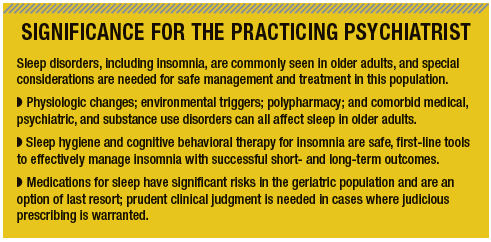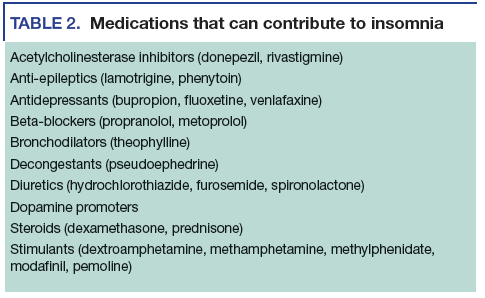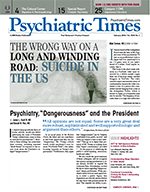Understanding Sleep Disorders in Older Adults
Given the impact of sleep on quality of life, cognitive functioning, and health outcomes, understanding sleep disorders in older adults is vital to their overall care.

Dr. Richards is a Resident Physician in Family Medicine and Psychiatry, UC Davis Health; Dr. Demartini is Chief Resident Physician in Internal Medicine, UC Davis Health, Internal Medicine and Psychiatry; and Dr. Xiong is Associate Professor, UC Davis Health, Internal Medicine and Psychiatry.
Sleep disorders are highly prevalent in the older population and frequently encountered in psychiatry and primary care. More than one-half of the elderly have at least one sleep complaint.1 Given the impact of sleep on quality of life, cognitive functioning, and health outcomes, understanding sleep disorders in older adults is vital to their overall care.
The most common sleep disorder both in the general population and in seniors is insomnia. Women tend to have a higher incidence of insomnia than men. Findings indicate that insomnia affects 31% to 38% of adults aged 18 to 64 years but 45% of those aged 65 to 79 years.2 Many factors can contribute to insomnia, including psychiatric or neurological disorders, medical conditions, polypharmacy, medication adverse effects, substance use, environmental changes (home, hospital, care home), decreased sensory input (blindness, deafness), unrealistic expectations of sleep, lifestyle changes (retirement, change in daily structure), and psychosocial stressors.
Related content: Mini Quiz: Sleep Hygiene
In addition to insomnia, several other sleep disorders are more often seen in older adults. Obstructive sleep apnea is especially common and affects 25% to 35% of people aged over 60 years, compared with 2% to 4% of 30- to 60-year-olds.3 Rates of sleep apnea are higher in men than women and are highest among institutionalized elderly adults (33% to 70%), particularly those with dementia.3 REM sleep behavior disorder is characterized by acting out dreams during sleep due to lack of muscle atonia and primarily affects elderly men. Additional disorders include circadian rhythm disorders (shift in the sleep-wake schedule), periodic limb movement disorder (repetitive and stereotyped limb movements during sleep), and restless legs syndrome (uncomfortable urge to move prior to sleep onset).
TABLE 1. Medical conditions that can contribute to insomnia

TABLE 2. Medications that can contribute to insomnia

FIGURE. Treatment algorithm for sleep disorders in older adults

Changes in sleep patterns with aging
As our brains age, physiological changes alter the timing and quality of sleep. Older adults frequently report waking up at earlier times, increased sleep-onset latency (taking longer to fall asleep), more nighttime awakenings, and decreased total sleep.3 With aging, progressively more time is spent in light sleep (stages 1 and 2), and less time is spent in deep sleep (stages 3 and 4). In addition, REM sleep is decreased. As sleep becomes more fragmented, there are more frequent shifts between sleep stages and more opportunities for awakenings.
Changes in circadian rhythm can also occur, because of decreased responsiveness of the superchiasmatic nucleus (which controls our internal clock) to external cues (light). Circadian rhythm dysfunction can be exacerbated by the loss of daily structure (or typical work routines), increased daytime napping, or inconsistent exposure to light, such as in nursing homes where day and night blend together. This often leads to advanced sleep phase syndrome, a circadian shift in the sleep-wake cycle where older adults feel tired earlier and earlier each evening, and then wake up earlier and earlier each morning. These changes in sleep architecture can result in less total sleep, decreased sleep efficacy (the proportion of time asleep compared with time in bed), and early morning awakenings.
Medical disorders, substance use disorders, and medications
Older adults often have one or more medical comorbidities that can contribute to difficulty with sleep. Data from an epidemiologic study of 6800 elderly adults over 3 years showed that only 7% of the cases of insomnia were in isolation of common comorbid conditions.4 Heart disease, diabetes, and respiratory disease were all associated with long-term persistence of insomnia at the 3-year follow-up (Table 1).
Related content: 14 Medical Conditions That Contribute to Insomnia
Finding and treating the underlying cause of the sleep disturbance is critical to effective management. For example, awakenings from sleep to urinate can be triggered by nocturia from benign prostatic hyperplasia, from polyuria with diabetes, from drinking water or alcohol too close to bedtime, or from evening doses of diuretics.
Substance use is often under-reported in older adults and can adversely affect sleep, especially with metabolic changes with age. For example, caffeine can have a stimulant effect for over 8 to 14 hours in older adults, and alcohol can also take longer to metabolize, leading to disrupted sleep and nocturnal awakenings. Nicotine can also interfere with falling asleep and decrease sleep duration. These changes increase sleep fragmentation and can worsen symptoms from other sleep disorders, such as obstructive sleep apnea.
Careful review of pharmaceutical agents is necessary in geriatric patients with sleep disruptions (Table 2). Older adults, especially those with multiple psychiatric or medical comorbidities, are usually excluded from clinical drug trials. Clinicians also must consider reducing usual doses for older adults, as there is increased accumulation of drug due to a larger volume of distribution (the elderly have a higher relative ratio of fat to muscle) and decreased drug clearance (due to age-related decrease in renal or hepatic function). Furthermore, older adults have a higher risk of adverse events related to polypharmacy, so clinicians should consider stopping or decreasing the dose of a current medication before adding a new medication.
Patient education regarding timing of medications is advised, so that stimulating medications are taken in the morning and sedative medications are taken in the evening. Medications intended to treat insomnia, such as antidepressants, benzodiazepines and their agonists, antipsychotics, and antihistamines, can cause excessive daytime sleepiness in older adults, which may lead to delirium, falls, or rebound insomnia, or paradoxically disrupt the sleep-wake cycle.
Psychiatric disorders and risks of antipsychotic use for insomnia
When assessing sleep, screening for psychiatric disorders is vital because many people with depression or anxiety initially present with insomnia or fatigue. In one study, 65% of patients with depression, 61% of patients with panic disorder, and 44% of patients with generalized anxiety disorder reported insomnia.5 Patients with PTSD can also have disrupted sleep with distressing nightmares. These diagnoses may be unrecognized or undertreated in older adults.
Inadequate sleep can also worsen psychiatric disorder symptoms and can contribute to suicidality. In one 10-year study among older adults with poor quality sleep, the risk of death by suicide was increased 1.4-fold.6 Similarly, in a 2-year prospective study, risk of depression recurrence was 5 times more likely in older adults with insomnia, independent of other symptoms of depression, antidepressant use, other medical comorbidities, or socio-demographic factors.7 This model predicted that treating 5 cases of insomnia could prevent one patient from relapsing into depression.
Although second-generation antipsychotics are often used for bipolar spectrum and psychotic disorders in older adults, these medications are frequently prescribed off-label for sleep or sedation. A meta-analysis on the off-label use of second-generation antipsychotics showed that there was a small benefit in using them for psychosis, agitation, and other behavioral symptoms in elderly patients with dementia, but there was not enough evidence to justify their use for insomnia.8 Furthermore, adverse effects, especially cardiovascular symptoms, fatigue, extrapyramidal symptoms, falls, and urinary symptoms were common, and there was a 1.5-fold increase in risk of death.
Treatment recommendations
To effectively manage sleep disorders in older adults, physicians must first screen for symptoms of fatigue or poor sleep. Next, a thorough history that includes symptom severity, chronology, exacerbating/alleviating factors, associated symptoms, sleep-wake patterns, and details about the sleep environment is gathered. A sleep log is a helpful tool for collecting additional data. Medical history, psychiatric history, substance use, and medications should also be reviewed for potential triggers. Then, a physical examination (focusing on the oral cavity, neck, heart, and lungs) and a mental status exam are done. Basic laboratory studies can screen for thyroid disorders, anemia, liver/renal dysfunction, and blood glucose abnormalities. Any signs of untreated medical conditions or sleep disorders (such as obstructive sleep apnea) should be further evaluated. (The Figure illustrates a suggested treatment algorithm.)
The first step in treatment is to optimize management of comorbid medical, psychiatric, or substance use disorders as these often can contribute to insomnia. Without treatment of the underlying etiology, the sleep dysfunction is unlikely to resolve.
Improving sleep hygiene is very effective and low-risk in older adults. Interventions include establishing a consistent bedtime that is late enough to decrease early morning awakenings, finishing meals several hours before going to bed, having a relaxing bedtime routine, minimizing caffeine/alcohol/nicotine intake, managing stress, and increasing morning exercise. Older adults should avoid wake-promoting activities, such as daytime napping, using the bed for activities other than sleep, and looking at the TV/computer before bed, as the light can be stimulating. Instead of lying in bed awake and watching the clock, getting up and doing a soothing, non-stimulating activity can be helpful. The bedroom should be comfortable, cool, dark, and quiet (except for white noise or a fan). Progressive muscle relaxation (thoughtfully recognizing and controlling muscle tension), biofeedback, listening to music, or meditation can also be helpful.
Cognitive behavioral therapy for insomnia (CBT-I) is a recommended first-line treatment, as it “produces reliable, durable benefits in 70% to 80% of patients, may reduce the use of sedatives, and improves time to fall asleep, continuity, restfulness, and duration of sleep.”9 CBT-I was found to be superior to medication use in short- and long-term management of insomnia in older adults. It improved sleep efficiency, reduced sleep latency, and decreased time awake during the night.3,9
Strategies of CBT-I include correcting cognitive distortions about insomnia, improving sleep hygiene, addressing maladaptive behaviors, reducing stimuli that promote wakefulness, and incorporating relaxation training/biofeedback. Patients can receive CBT-I through trained therapists or self-guided modules. Brief behavioral treatment for insomnia (BBTI) is derived from CBT-I but delivered in one session with 2 to 3 brief follow-ups, focusing on sleep consolidation.10
When medications are considered for insomnia, shared decision-making with the patient is necessary given that the risks of medications can be severe and include delirium, agitation, falls, and drug-drug interactions (Table 3). Zolpidem has been implicated in more than one-fifth of all emergency department visits for psychotropic adverse drug events in older adults.11 Moreover, data studies that show drug efficacy are limited and often weakened by biases from corporate sponsorship, short follow-up, comparison with placebo only rather than standard treatment, and small sample sizes.10
Ideally, medications should not be used alone as the only treatment, and should only be used as short-term adjuncts to behavioral management in cases where benefits of medication outweigh risks. Practical recommendations are to choose a medication with a shorter half-life to minimize daytime drowsiness, and to use the smallest effective dose for the shortest duration of time (3 to 4 weeks only) with intermittent dosing (as needed rather than daily). For older adults, use lower starting doses (half of normal dose), given the increased risk of adverse effects.
Because pharmacotherapy is not intended for long-term use, non-pharmacologic and/or behavioral interventions should always be emphasized concurrently. This can ease rebound insomnia and anxiety associated with discontinuing medications once the short course has ended. Medications are an option of last resort in limited circumstances, and prudent clinical judgment is necessary for cases in which judicious prescribing is warranted.
The authors report no conflicts of interest concerning the subject matter of this article.
References:
1. Foley D, Monjan A, Brown S, et al. Sleep complaints among elderly persons: an epidemiological study of three communities. Sleep. 1995;18:425-432.
2. Alessi C, Vitiello M. Clinical evidence handbook: primary insomnia in older persons. Am Fam Physician. 2013;87:280-281.
3. Roepke SK, Ancoli-Israel S. Sleep disorders in the elderly. Indian J Med Res. 2010;131:302-310.
4. Foley DJ, Monjan A, Simonsick EM, et al. Incidence and remission of insomnia among elderly adults: an epidemiologic study of 6,800 persons over three years. Sleep. 1999;22:S366-S372.
5. Ohayon MM, Roth T. What are the contributing factors for insomnia in the general population? J Psychosomatic Res. 2001;51:745-755.
6. Bernert RA, Turvey CL, Conwell Y, Joiner TE Jr. Association of poor subjective sleep quality with risk for death by suicide during a 10-year period: a longitudinal, population-based study of late life. JAMA Psychiatry. 2014;71:1129-1137.
7. Cho HJ, Lavretsky H, Olmstead R, et al. Sleep disturbance and depression recurrence in community-dwelling older adults: a prospective study. Am J Psychiatry. 2008;165:1543-1550.
8. Maher AR, Maglione M, Bagley S, et al. Efficacy and comparative effectiveness of atypical antipsychotic medications for off-label uses in adults: a systematic review and meta-analysis. JAMA. 2011;306:1359-1369.
9. Trauer JM, Qian MY, Doyle JS, et al. Cognitive behavioral therapy for chronic insomnia. Ann Intern Med. 2015;163:191-204.
10. Buysse DJ, Rush AJ, Reynolds CF. Clinical management of insomnia disorder. JAMA. 2017;318: 1973-1974.
11. Hampton LM, Daubresse M, Chang HY, et al. Emergency department visits by adults for psychiatric medication adverse events. JAMA Psychiatry. 2014;71:1006-1014.

